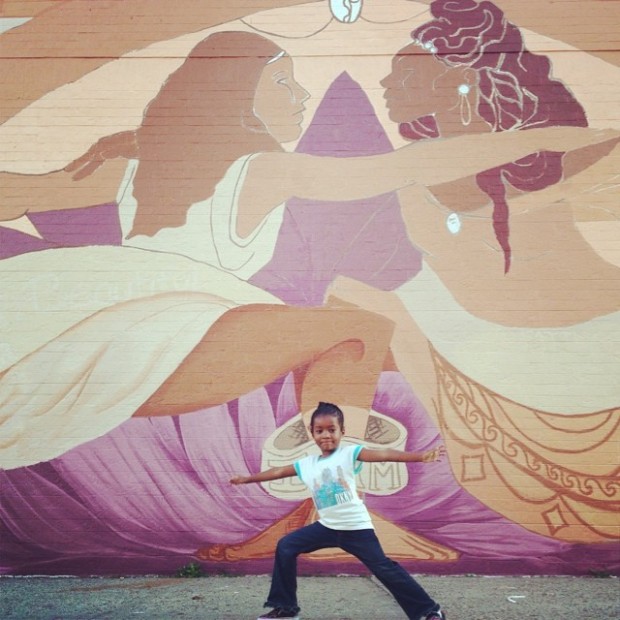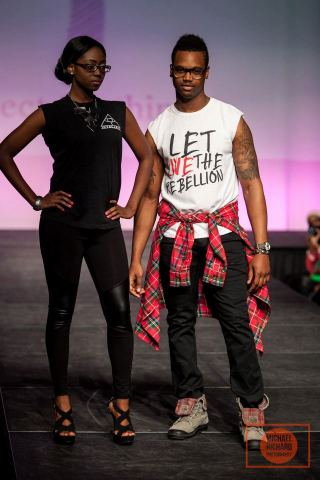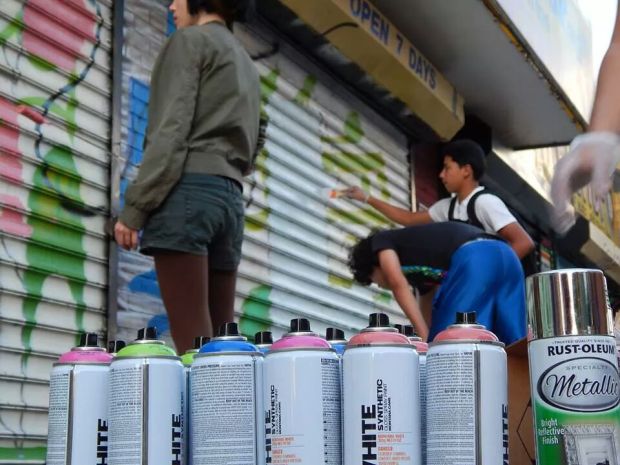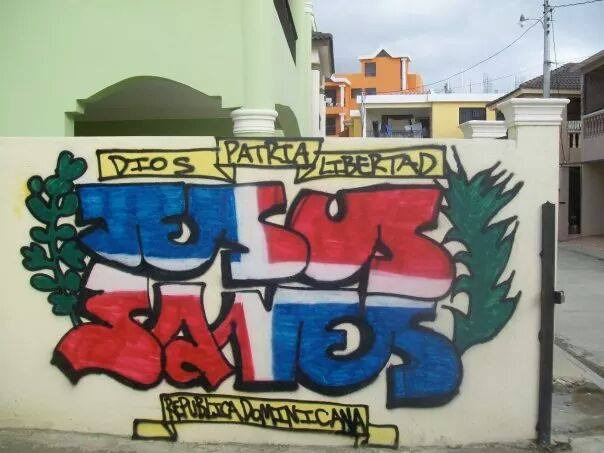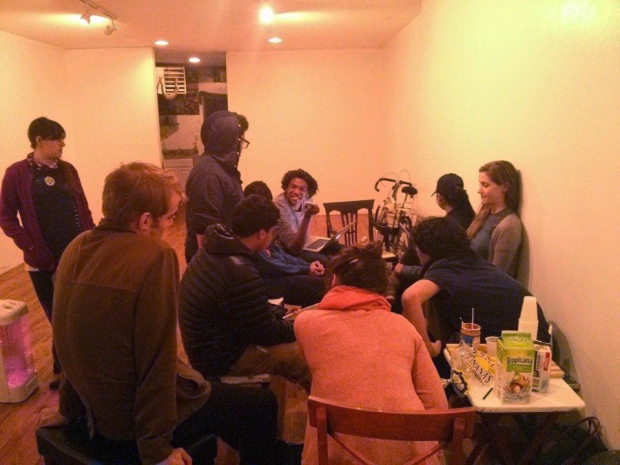by Sarah Quinter
This summer, “Guided Gateways,” a 22’ by 109’ mural designed to spark dialogue about reproductive health in was unveiled on Wyckoff Avenue and Putnam Street. The mural was a project of lead artist Crystal Clarity in partnership with teen participants in Groundswell’s Voices Her’d Visionaries leadership development program.
I visited the mural site several times and spoke with the young women working on the mural. They told me that they started in the spring by discussing issues of teen pregnancy and women’s empowerment. They came up with five issues they wanted to address through the piece: consent, the restriction of access to reproductive care, the shaming of teen pregnancy, accessing knowledge around women’s well-being, and communication between generations of women. They then did word association sketches to generate images for the mural. Crystal then helped the young women unify their ideas into a single composition, and the team got to work. They told me that the feedback they got from passers-by was mostly positive, though some males questioned why there were no males on the team or depicted in the mural. This sparked dialog about how women’s perspectives were rarely given center stage, and the importance of providing venues for those perspectives. The teen artists spoke to me about how the project not only helped them strengthen their skills, but gain confidence in their voice and community. After the unveiling ceremony on August 28th, I interviewed Crystal via email about her work as an artist and educator and her connection to the neighborhood:
What’s your connection to Bushwick? What are your feelings about this neighborhood?
I started teaching at the El Puente Bushwick Center around 2002. It was my first art teaching gig and I found there a community I had been looking for for a long time. I taught there for about five years and watched a lot of young people grow up there. I grew up there too! My first apartment as an adult was in Bushwick on Jefferson Street – it is a very special neighborhood to me. It’s full of families and people like my parents who are here in the US trying to raise their babies the best they can. Working class mostly Latino peoples – my peoples. I feel very much at home here.
The first large-scale community mural I ever painted is here in Bushwick – “Time Flies: A Brief History of Bushwick” on Knickerbocker Avenue and Woodbine Street. I was part of a huge crew of amazing community-minded artists working with El Puente. My mentor Joe Matunis, a serious muralist, gave me the centerpiece to rock and it was everything! I became a muralist here. I became a teaching artist here – this was the foundation for the rest of my life’s work. Now I feel I have come full circle with this mural I have led and given other young artists space to rock – it is my/our best work to date. I will always have tremendous love and respect for Bushwick.

Please describe your current project. What has been the process for the mural, and what do you hope to communicate?
This project is a Groundswell Program called Voices Her’d . It was started by Katie Yamasaki and is designed to give voice and stage to critical issues that young women are dealing with. It is led by women artists with a theme chosen by youth. This year’s theme was teen pregnancy and female empowerment. We started by looking at how this conversation is being held in public space. We looked at the recent PSA’s of crying babies with shaming narratives blaming young mothers for the ills of society. We talked about how this conversation is held at home and in schools if at all and concluded the base of all these conversations was coming from a place of shame, fear and judgment. We decided to construct our narrative addressing that and also expanding the narrative socially, personally and politically. The politics of men making decisions for women’s bodies is addressed — advocacy for reproductive justice is encouraged. Access to sex ed, contraception and abortion should be issues where women have full autonomy. Shaming is present in the mural because it’s a reality, but it’s dwarfed by images depicting the kind of positive and powerful relationships young women need to have with older women to initiate safely into womanhood. Conversations with partners and consent and mindfulness is encouraged. A young woman is shown balancing a child with her school books and talents while standing on an alarm clock, and conversations with families about sex is encouraged.
In fairness – art has a way of meaning different things depending on the viewer. I’ve noticed people on the street pointing and talking to each other – they talk to us and tell us what it means to them. Some get precisely to the letter what we are saying, some misinterpret, some are offended (mostly homophobic men petrified of being excluded in a woman’s vision of power). Or just afraid of women’s power.

What themes have you explored in your work over the years? Who are your audiences and what kinds of messages have you aimed to convey?
My work primarily serves and celebrates women of color – women of the Afro-Caribbean and indigenous diaspora. I aim to decolonize the image of black and brown bodies and return us to the throne of our original power and dignity. I want to create images that counter the spiritually and mentally damaging visual culture that surrounds us and programs us everyday.

You’ve worked with young people for a long time as an artist and an educator. What values and skills do you try to impart to them? What principles or values inform how you interact with youth?
It is important to me when working with young people – especially youth of color – to first create a safe space and a place of mutual respect and appreciation. Non-judgment and gratitude and respect are foundation. But best practice in anything is emphasized. They need to be prepared to work hard and I don’t give a lot of space for lame excuses that we are programmed with from birth to tame our limitless potential. They have to show up and they have to try and they have to be honest, not for me or for a program, but for themselves. I lead with them as leaders beside me. I value their ideas and objections and respect their concerns and fears, as long as they are not excuses to stop looking for a solution. My major principles are reciprocity and each one teach one and I let them know at any given moment that I have something to learn from them and that I’m not the only one with valuable knowledge and experience.

Do you have a memorable story to tell about being an educator?
I always tell this story about the first big mural I worked on, the one in Bushwick on Knickerbocker with the two spiraling birds on the corner. I was so intimidated by the scale, it was the biggest thing I had ever been responsible for designing. I was about to start working on the gigantic feathers with one other youth. I looked at him – we looked at each other and he says,” It’s so big, I’m scared to paint this, I’m scared to mess up.” I said, “Me too, all day, but let’s do it anyway.” We just started rocking out and overcame that together. I think it’s important to show kids that it’s ok to be scared or vulnerable and make mistakes. But it’s not ok to let it stop you from pushing forward.

What artistic and cultural influences have shaped your style and aesthetic?
I’m a NYC baby – an 80s baby – a child of hip hop and of the inner city. I’m a Boricua – all of these modalities shape my expressions, visual and lyrical/ poetic, etc.
What media have you worked with and what have made them important to you? (murals, printmaking, etc)
Drawing is fundamental, but I regrettably don’t do it nearly enough. Murals have been a huge part of my creative practice over the past ten years and sometimes I feel the need to expand inward from the community to my individual voice. I’m working on giving myself permission to do that. I always feel such a harsh sense of responsibility and obligation to the greater voice and vision of people in struggle. Murals are important to me as a people’s art – a democratic art form.
Printmaking is my second love for similar reasons, but I love its ability to still be a people’s art and tool for disseminating information but while retaining a space for the individual artist to flex. I love printmaking and murals – I could do it till I’m done!

Where do you hope to take your work as an artist and educator in the future? What’s on the horizon for you?
I really want to create for myself the kind of artist residencies that take what I love doing and help really amazing people and organizations with their visual presence. I want to work more on my printmaking and teach silkscreen 😉
Is there anything else you’d like to add? Some advice to aspiring artists?
Do what you love and love what you do. Make purpose primary and everything else will line up. Don’t chase money – it’s not real. What you do and leave behind is the wealth you seek. Everything leads to the next thing. Be generous with your talents and heart but don’t let people exploit you. Be disciplined but live your life! Have fun. Dig deep. Integrity is everything. Say yes a lot but learn when to say no. Hydrate. Exercise. Love abundantly, create constantly.
Love ,
Clarity
